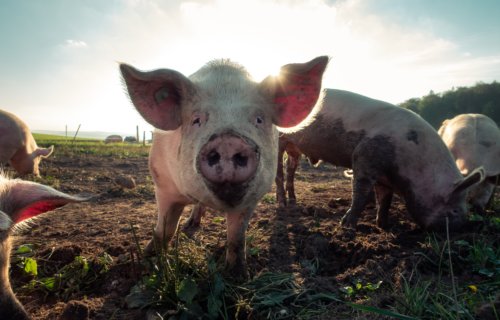STANFORD, Calif. — Pigs, chickens, and rats could hold the key to beating Covid-19, according to new research. They are immune to the coronavirus because of the shape of their cells, say scientists. The study out of Stanford University explains why some animals, including cats and cattle, are prone and others are not.
The discovery could lead to a drug that uses an artificial “lock” to trap the bug and prevent it from interacting with cells. It’s believed the pandemic began when the SARS-CoV-2 virus, that causes Covid-19, jumped from bats or pangolins to humans.
Researchers investigated how the “spike” protein hooks onto cells. SARS-CoV-2 enters cells by attaching to a specific gene known as angiotensin-converting enzyme 2, or ACE2. These receptor genes are on the surface of your cells. Computer simulations showed for the first time how it attaches itself to different ACE2 receptors, similar to checking a key. They demonstrated the “locks” of certain animals fit better, including humans. This makes those species more susceptible to infection.
The 3D models also identify certain structural features unique to these species. Other creatures are immune because their ACE2 receptors lack them, leading to weaker communication.
Stanford’s Dr. Joao Rodrigues, lead author of the study, says it opens the door to the development of a medication. It could also help prevent future outbreaks by monitoring animal hosts from which a virus could potentially infect humans.
Coronavirus is no stranger to animals
Covid-19 has been reported in cats in the U.S. and Belgium, minks on Dutch farms, and even in lions and tigers at the Bronx Zoo in New York.
“In all these cases, the vehicle of transmission appears to be an infected human owner or handler. More importantly, in the case of the mink farms in The Netherlands, there is evidence of human-to-animal-to-human transmission,” the authors write.
Studies have shown camels, horses, sheep and rabbit can also be infected, but not chickens, ducks, pigs, mice and rats. The coronavirus has already killed around 1.5 million people across the world – and infected an estimated 65 million to date. Environmentalists fear the world is on the brink of a spate of pandemics as habitat destruction brings humans into closer contact with wildlife populations.
The study is the first of its kind involving a detailed analysis of 29 vertebrates ranging from humans, chimpanzees and dogs to goldfish, crocodiles and hedgehogs. Researchers used open-access data, pre-prints and freely available academic software. Rodrigues says the models shed fresh light on why some species do not catch the virus.
“We went from wondering if tigers could catch Covid-19 to having 3D models of protein structures offering a possible explanation as to why that is the case in just a few weeks,” he says.
To reduce the risk of infecting domestic and wild animals, including endangered species, he recommended following the World Organization for Animal Health guidelines.
“People infected with Covid-19 should limit contact with their pets as well as with other animals including humans,” suggests Rodrigues.
The study is published in PLOS Computational Biology.
SWNS writer Mark Waghorn contributed to this report.
